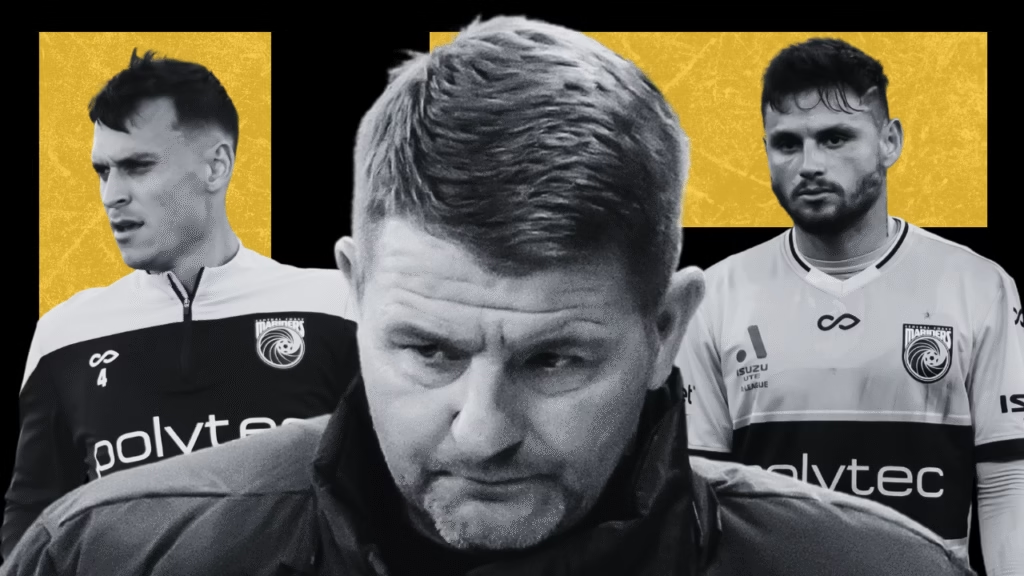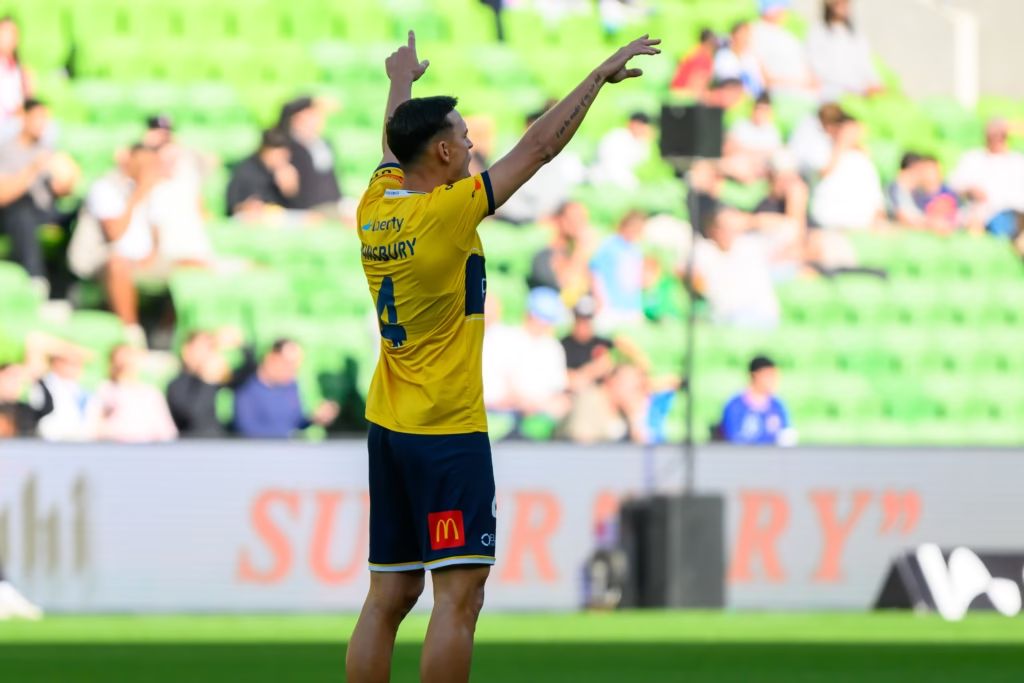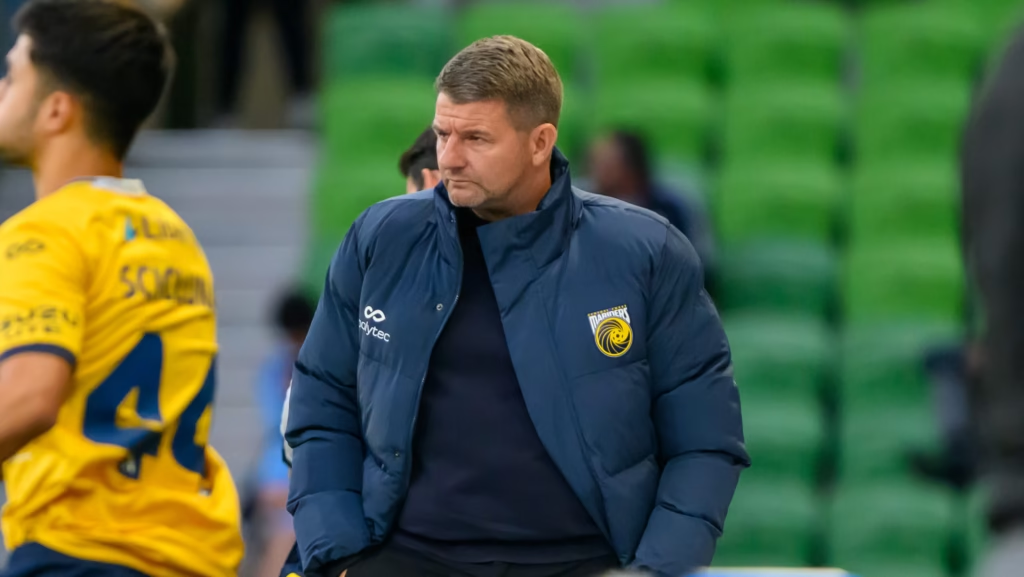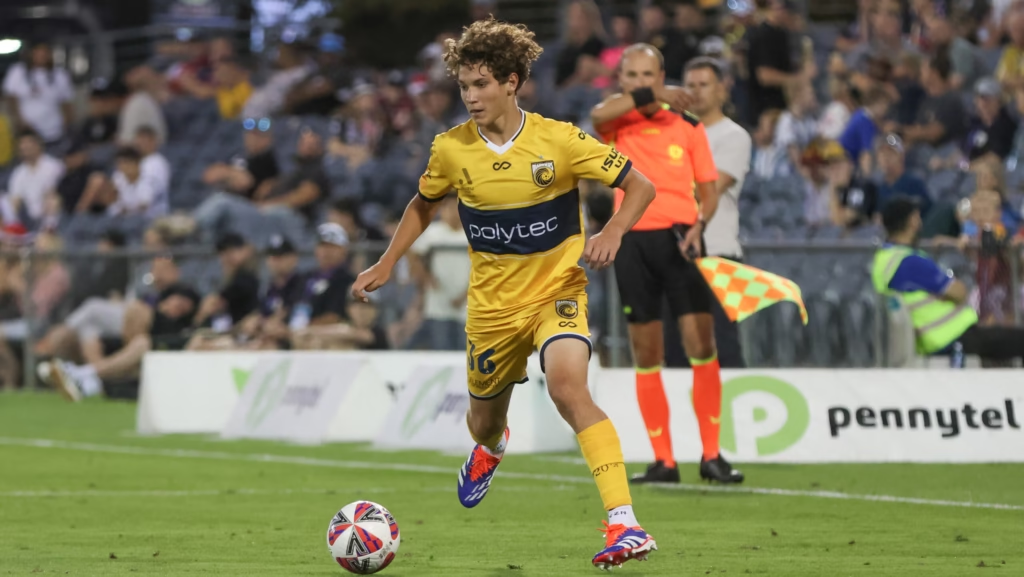
Central Coast Mariners 2024/25 A-League Men's season review. Photos: Marcus Robertson and Texi Smith / Round Ball Australia.
The Central Coast Mariners redefined success in a historic 2023/24 season, coming away as treble winners and surpassing all expectations by winning the AFC Cup, and both of the A-League Men Premiership and Championship, in Round Ball Australia’s next season review.
Nothing the Mariners could produce in the 24/25 season would come close, especially as they faced a much tougher task in Asia now finding themselves in the premier AFC Champions League Elite competition.
Mark Jackson was still at the reigns, and faced an identical challenge as he did coming into his first season at the club; how do you deal with the turnover of players that in inevitable for any champions from a selling league?
The list of departures made for grim viewing, with this crop different to previous in the way that many big chunks of the soul of the club were going, not just the most talented players.
You can replace talent on the field, but you simply cannot replace heart, which players like Josh Nisbet, Jacob Farrell, Max Balard, and Danny Vukovic had in spades.
Expectations were lowered heading into 24/25 as you can’t go much higher than the ceiling, but the goal of defending their domestic honours certainly remained.
The passing mark was finals at a minimum, and with what looked to be some smart moneyball-esque acquisitions this looked plausible for what still remained a talented squad.
Trent Sainsbury, a former Central Coast favourite headlined the arrivals, alongside Alfie McAlmont who came from Mark Jackson’s former player scouting network.
Vitor Feijao was the Brazilian lower league punt of choice this time around, with defensive cover in Diesel Herrington and attacking fullback Lucas Mauragis arriving on the coast.
After all was said and done, Jackson was faced with replicating what he had done in the previous season, so heading into 24/25 there was no reason the Mariners couldn’t go on to find some form of success.

Season Grade: C-
With finals as an expectation, the Mariners fell well short of meeting the benchmark in the end.
If developing and blooding in the promising youngsters into the first team was the benchmark, then the Mariners were not far off a passing mark.
One alternative takeaway from the season would be that many of the young players in the squads had their transfer market value increase massively, namely Dylan Peraic-Cullen and Haine Eames.
In terms of reinforcing the dominant performances style we had seen over the past two seasons, Jackson was unable to reach those same heights with his new look squad and a slow start to the season petered out into an even slower ending.
The depth of the side was simply not there in order for them to compete in the ACL Elite and the A-League, and this was evident in their results in Asia where they finished the group stage with one draw and six losses from seven games (another loss was recanted after a team withdrawal).
This tally would have sat at seven losses had Shandong Taishan not withdrawn from the competition under what remains unclear circumstances, leaving the Group A table lopsided with some teams playing more official games than others in the standings.
They were outclassed by opponents and only looked like they were up for games once they had gone behind by one or two goals, but time and time again it was too little too late.
Throughout the early rounds of the A-League there were points at which Central Coast looked as if they were ready to kick into gear and hit their strides, however this catalyst moment never happened and consistency between results looked few and far between.
There was never really a point where it looked like there was a sense of belief throughout the squad, and understandably it proved too tall an order to match any of the achievements of the previous years, leading to a generous C- for Mariner’s 24/25 efforts.

Shifting formations
One of the reasons causing the lack of consistency for the Mariners was Mark Jackson’s constant tweaking of the team set-up.
It’s a double-edged sword on your search for the right formula as a manager, as specific systems may need more than a few game weeks in order to develop, but if you aren’t seen to be making changes then fans will grow wary and wonder why you are content with mediocrity.
In total there were seven distinct starting formations, although Jackson often remarked on the fluidity of their structure, so it is hard to paint these all in the same way.
For example, there could be consecutively played 4-4-2 systems with a difference in personnel and functionality of the roles between games, such as pairing Alou Kuol and Ryan Edmondson up top or having Bailey Brandtman or Miguel Di Pizio playing off one of the traditional striking options.
Either way, it never looked like Jackson settled on a distinct style for his side and that made it difficult to build any sort of rhythm, and with the squad chopping and changing week to week it was equally as hard for the players to build momentum for themselves.
We saw wingbacks come and go, Mikael Doka as a number 10, Kuol and Edmonsdon as dual nines. It was a little bit of everything which evidently meant that it was a whole lot of nothing.
Fans struggled to get behind a team that lacked the clear identity and purpose of the previous season, and you could see that with a steep decline in attendances across the season, which is disappointing for defending champions of the league.
Investing in the future
There were more lows than there were highs for the Mariners, however some individuals did manage to make their mark this year and showed that as always, the Coast can produce top-quality talent from within their academy system.
Haine Eames was arguably the most notable of the lot, and became the Mariners’ youngest ever debutant, starter, and goal scorer at the age of just 16.
He impacted games in ways that very few have at his age, and doing this in the ACL makes the feat all the more impressive, which is why he understandably took home the Newcomer of the Year award for 2024/25.

Mikeal Doka did not have an effective year by the high standards he set in his first season down under, but he was still Central Coast’s most influential player in nearly every game played, which meant he was deserving of the Mariners Medal and the Supporters Club POTY trophy.
The biggest under-performers were the centre back partnership of Trent Sainsbury and Brian Kaltak, the latter being the more surprising inclusion in this grouping as he had been one of the most consistent performers in the entire league in the two years that preceded this one.
Nathan Paull often was the most impressive in the Mariners backline as the two veterans were often on the end of uncharacteristic errors that meant Central Coast began games on the back foot too often to be considered contenders for the finals.
Paull was rewarded with Coaches’ Player of the Year, and the club will have a hard time keeping him on the books as other teams start to circle for his signature.
Rebuild and go again
So, what next for the Mariners? How can you hold them to higher standards than what has been produced in the last few years for a side who more seasons than not are the lowest spenders in the competition?
First, the ownership situation needs to be finalised in some way, with rumours that Mike Charlesworth is halting all transfer activity for the side until talks with a potential new ownership group materialise.
Without that step, the future remains murky but there are some bright spots to cling onto for fans. There is enough talent remaining in the squad to still be in the conversation come next season, and with Mark Jackson at the helm he has shown that he can work miracles with an underrated and undervalued squad.
